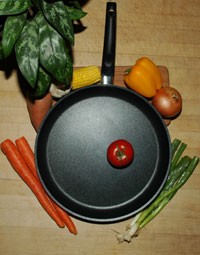|
|||||||
|
During my 35 years of medical practice I have never seen, or even heard of, anyone becoming sick or dying from exposure to the components of the non-stick surfaces of pots and pans. However, I have seen thousands, and heard of hundreds of millions, of people made sick by eating grease. The purpose of non-stick pans is to cut out the vegetable oils and animal fats used in cooking and help prevent “lipotoxemia”—that is, poisoning from lipids (fats). The most common diseases occurring from chronic fat poisoning are obesity, heart disease, cancer of the breast, colon, and prostate, and type-2 diabetes. Use of non-stick pans also eliminates the risk of common stovetop grease fires. Although nonstick has revolutionized America's cooking habits over the past fifty years, this article should not be interpreted as an unqualified defense for the potentially toxic materials used in non-stick pans, but rather as an attempt to put the issues into perspective. PFOA Concerns The chemicals of most concern are from a family called perfluorooctanoic acid (PFOA). These are found in the blood of more than 95% of Americans and have been tied to cancer and developmental damage in animal studies. The EPA has asked eight manufacturers that use PFOA to reduce production by 95% by 2010 and to stop using it altogether by 2015. PFOA is used in many household products, including cookware, carpets (Stainmaster carpet treatment), draperies, pillows, adhesive tape, clothing, and food packaging (from microwave popcorn bags to pizza box liners). Cookware is only a very small fraction of our daily exposure.
Teflon® branded non-stick coatings are made solely by DuPont. According to DuPont’s web site, significant decomposition of the coatings occurs only when temperatures exceed about 660°F (349°C)—well above the smoke point for cooking oil, fats or butter. However, these high temperatures can be reached if dry or empty cookware is neglected on a hot burner or in an oven. PFOA materials released at high temperatures have been known to kill caged pet birds. Not surprisingly, a recent study supported by DuPont concluded, “…exposures to PFOA during consumer use of the articles evaluated in this study are not expected to cause adverse human health effects in infants, children, adolescents, adult residents, or professionals nor result in quantifiable levels of PFOA in human serum.”1 However, this same company agreed in December 2005 to pay $10.25 million in fines and $6.25 million for research and education to resolve federal charges that it hid information about the dangers posed by PFOA. Another independent study researched the effects of heating non-stick pans to 320°C and found that PFOA was not generated from the pans by heating.2 They reported that paper treated with PFOA resulted in the largest potential for exposure for people. For example, the amount of toxic materials released from popcorn bags was found to be hundreds of times greater than from the first use of non-stick cookware heated to 175°C. With repeated use of the cookware the amount of PFOA released approaches zero. Inert Cooking Surfaces are Safest About 15 years ago manufacturing processes for making non-stick pots and pans improved dramatically—with the use of powders made out of ceramic, stainless steel or titanium. The coatings were also applied much more thickly to better quality aluminum pans. Ø Coatings are known by their brand names and a few examples are: Teflon®, Xylan®, Excalibur®, Ultralon®, and Silverstone. Ø There are too many manufacturers of high quality non-stick pans to list, but popular ones are: All-Clad, Anolon, Berndes, Calphalon Circulon, Cuisinart, Emerilware, Farberware, Revere, Scanpan, T-Fal, Viking, and WearEver.
Because of the low risk of harm from the minerals released we still recommend the use of iron, stainless steel and copper cookware. The more inert the cooking surface the better—ceramic, enamel, and glass cookware presently best fit this criteria. Wood (bamboo) for steaming is also very safe. We also use inert silicone-based products (SiliconeZone) for baking. My conclusion is that high-quality, non-stick pots and pans present very inert surfaces unless they are misused—specifically by overheating which causes the release of toxic fumes (chips from the surface are inert and inconsequential if swallowed). Look at the surfaces of your pots and pans to be sure they are in good condition and covering the aluminum bases. Unless future evidence of actual harmful effects from using PFOA-based non-stick cookware becomes available, I will continue to recommend their use, because presently the real-life advantages outweigh their theoretical risks. References: 1) Washburn ST, Bingman TS, Braithwaite SK, Buck RC, Buxton LW, Clewell HJ, Haroun LA, Kester JE, Rickard RW, Shipp AM. Exposure assessment and risk characterization for perfluorooctanoate in selected consumer articles. Environ Sci Technol. 2005 Jun 1;39(11):3904-10. 2) Begley TH, White K, Honigfort P, Twaroski ML, Neches R, Walker RA. Perfluorochemicals: potential sources of and migration from food packaging. Food Addit Contam. 2005 Oct;22(10):1023-31. <<< Return to Newsletter Home Page
|


 DuPont—the
Center of Controversy
DuPont—the
Center of Controversy